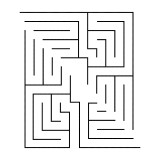The Labyrinth constitutes a widely known concept, with a variety of forms and contents, that may also consist of a broad and often unclear cluster of aspects and meanings; the references and the specimens, originating from the first historical manuscripts, and its uses until the present day, define it as an archetype, an intercultural symbol with multiple charges. As a part of the architectural discourse, it draws attention as a building of the mythical inventor and architect and is occasionally used either as it is, or through schemes and concepts it contains or refers to. The ways in which it appears, in all its paradigms and aspects, don’t bear a standard content or meaning. In any case, the Labyrinth concentrates figurative and symbolic meanings and is located in most mismatched places.
The first turn in a labyrinth must not beassociated merely with the change of direction or a bifurcation, but also with the point beyond which no entrance point is visible anymore. It notes the moment of understanding that the return to the exit is unsure and that the lucidity of the outer realmgrows further away. At this point, the following question rises: how is the concept of the Labyrinth constructed? And how does it come into an architectural context? A unique, exhaustive, precise and comprehensive definition is by default difficult and highly lacking. Therefore, the path to defining its meaning comes through its manifold presence. Thus begins the procedure of defining a center that might reveal the Labyrinth through its findings, evidences and uses, both literally and figuratively, within the realm of human activity.
